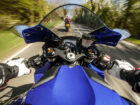With the risk of ice and snow, riding over the winter can be perilous. But if you’ve decided to rest up your bike until spring, it’s important to make sure it’s properly protected. To help avoid expensive damage, rust and corrosion, here are our top tips on how to prepare your motorcycle for winter.
1. Consider where to store your motorbike
Ideally, your motorcycle should be stored somewhere sheltered, where there is minimal risk of damp. A well-ventilated garage, shed or motorcycle shelter is ideal.
Whatever you choose, it’s a good idea to make sure your motorcycle is tucked away so it’s not being constantly brushed up against or is at risk of being knocked over. If you’re storing bikes outside in winter, make sure they’re secure and think about installing a ground anchor.
Alternatively, you could consider a specialist motorcycle storage facility. Although this can be pricey, it’s more likely to provide your motorcycle with heated storage and ensure it is kept at optimum temperatures.
2. Wash and dry your motorbike
Preparation is key to making sure your bike stays in tip top condition and is ready to go when the warmer weather arrives. With that in mind, making sure your bike is well washed and thoroughly dried is crucial.
Check air vents, gaps, holes and the exhaust for dirt and moisture which can lead to corrosion. Your bike should be bone dry before you even think about leaving it in storage.
3. Choose a motorcycle stand as part of your winter storage kit
Think about buying a motorcycle stand for winter storage – for example, a couple of paddock stands to keep wheels off the ground. This is because leaving your bike in one position can flatten the wheels over time.
If a motorcycle stand isn’t an option, put a rug or old piece of carpet in between your bike’s wheels and the ground. If you do this, remember to turn the wheels every so often to spread the load and keep tyres in shape. Otherwise, you can slightly over inflate the tyres to counteract the pressure but don’t forget to release the air before you get back on the road.
4. Warm up your motorcycle every so often
Some motorcyclists swear by warming up their bikes every so often, just to get it up to temperature. Others don’t think it’s such a good idea and argue it can lead to condensation building up and can damage the battery.
However, this doesn’t mean you have to take it out, you just need a well-ventilated garage or space to do this.
What you do is entirely up to you and you’re likely to know what works best for your bike, but if you’re not sure, check with your local garage.
5. Keep the battery charged
Keep your battery on a trickle charge to minimise the risk of it becoming flat. If you want, you could even remove the battery but if you decide to warm up your bike every so often, this can become time consuming.
6. Top up the fuel tank
Another point that’s often debated when it comes to motorcycle winter storage, is whether to top up your fuel tank or not.
The argument for, is that it lowers the risk of rust. Those against topping up your tank say that fuel degrades over time, and it could leave a gloopy mess at the bottom. However, if you are warming up your bike and turning the engine over, this should stop that from happening.
7. Plug gaps
Plugging gaps such as the exhaust and vents stops condensation and moisture from creeping in. More importantly though, it also stops mice from nesting inside your bike.
It shouldn’t be too much of a problem if you’re storing your motorcycle indoors in a spare room or secured garage. But if you’re storing bikes outside in winter, plugging gaps with rags or clothes is something to bear in mind. Just make sure you remember to remove them before you start to use your bike again.
8. Protect your motorbike from corrosion
Spraying your motorbike with an anti-corrosion lubricant can help keep it from corroding over winter.
9. Cover your motorcycle
Even if you’re storing a motorcycle indoors, you should ensure it’s covered. Ideally, the covering should allow air to circulate while keeping dust and debris off your bike.
You can of course opt for specially made motorbike covers for the most effective protection, but any fabric will do – for example, old curtains or even tablecloths.
10. Don’t forget the rest of your kit
Keeping your kit stored in one place over winter makes it much easier to find everything come spring. Of course, if you’ve only got one set that’s easy enough but if you’ve got a range of accessories for track days, touring or just everyday use, you can organise your kit with these great storage options.
Should I insure my motorcycle over winter?
If you’re preparing your motorcycle for winter storage, you might not feel the need for insurance. But, while cancelling your policy might seem the most cost-effective thing to do, it could work out to be a false economy.
Cancelling your motorcycle insurance policy will mean you won’t be covered if your bike is stolen or damaged by fire. If your motorcycle’s safely stored indoors, you might not view these events as potential risks, but that’s the point of insurance; it covers the incidents you least expect to happen. Cancelling can also mean you end up paying a fee.
Instead, speak to your insurer about laid up insurance for your motorbike, which will compensate you for fire and theft. These types of policies are a compromise between having no cover at all and offering protection while your bike is being stored for winter.
Policies are generally very flexible and can range from six up to 12-months’ worth of cover, giving you peace of mind that you’re protected for unforeseen circumstances even when you’re not on the road.
What happens if I SORN my motorbike over winter?
A SORN is a statutory off-road notification. It’s an official record that shows your motorcycle is ‘off the road’ so you won’t be able to ride it unless you’re on private property.
If you’re sure you won’t ride your motorcycle over winter, arranging a SORN can entitle you to a refund on your vehicle excise duty (VED) and help you claim back some cash. Just don’t forget to tax your motorbike again if you’re getting back on the road after a while.
Arranging a SORN is also the only time you can forego motorcycle insurance, but you don’t have to. Even if you have a SORN, you can still insure your bike – for example with laid up cover.
Motorcycle insurance for all seasons
Whether you’re a hardy all weather biker or prefer to store your motorcycle over winter, it’s vital to have insurance you can rely on.
At MCN Compare, we make searching for motorcycle insurance quotes quick and easy – simply answer a few questions and we’ll take it from there. For our best deals that fit your needs and budget, start your quote right now.









